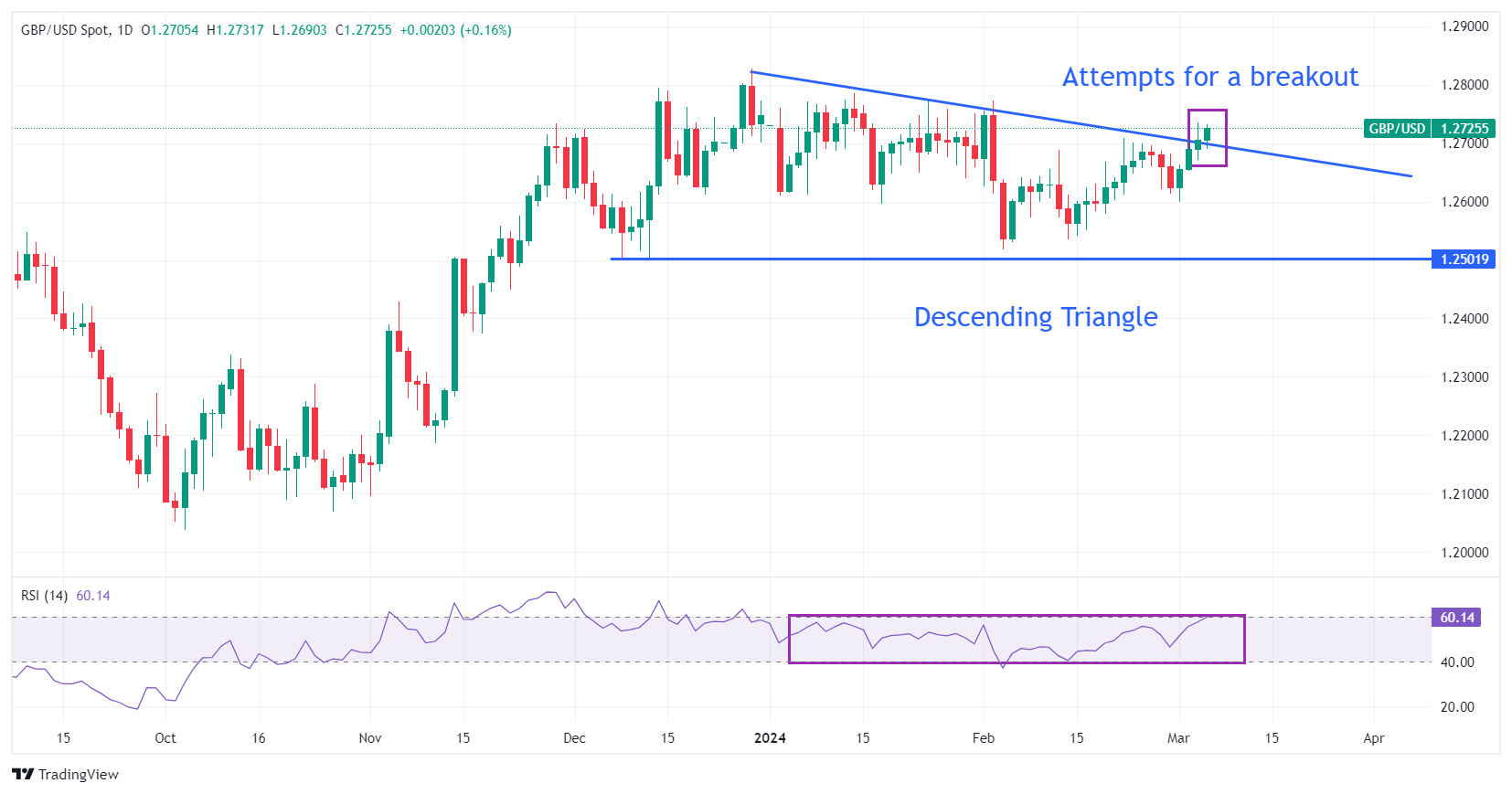Pound Sterling rises to monthly high ahead of UK Spring Budget, Fed Powell’s testimony

- The Pound Sterling could see a decisive break after a two-month consolidation depending on the outcome of the UK Spring Budget announcement.
- Measures outlined in the UK Budget could significantly impact the inflation outlook.
- The US Dollar will be guided by US private payrolls and Fed Powell’s testimony.
The Pound Sterling (GBP) strengthens slightly against the US Dollar in Wednesday’s European session ahead of the United Kingdom’s 2024 budget statement by the Chancellor of the Exchequer Jeremy Hunt. Investors will keenly watch the scope of fiscal stimulus as it could drastically impact the outlook on inflation and the interest rate outlook by the Bank of England (BoE).
Jeremy Hunt, who will present the budget from 12:30 GMT, needs to make a balancing act between measures to keep inflation at bay and cheering the public through tax cuts, with general elections expected later this year.
The Times reported that Jeremy Hunt is expected to announce a two-percentage-point cut to National Insurance Contributions (NICs), which should save the average earner around 450 pounds this year. Combined with last year’s cut, total savings for workers would be 900 pounds.
In the United States, investors will focus on the ADP Employment Change for February and Federal Reserve (Fed) Chair Jerome Powell’s testimony before Congress at 13:15 and 15:00 GMT, respectively. Powell’s guidance on the interest rate outlook could influence market expectations for Fed rate cuts as markets currently price in the first one in June.
Daily digest market movers: Pound Sterling strengthens as US Dollar slumps
- The Pound Sterling rebounds from 1.2690 after a corrective move. The GBP/USD pair is expected to remain on its toes ahead of Chancellor Jeremy Hunt Spring budget announcement at 12:30 GMT.
- In the 2024 budget statement, Hunt will present economic forecasts, fiscal stimulus measures, and borrowing outlook, among others. Market participants will keenly focus on the fiscal scope as it could be a game changer for inflation and the interest rate outlook. Large and unfunded fiscal stimulus could deepen fears of persistent price pressures, prompting the Bank of England to maintain the hawkish rhetoric.
- On Sunday at BBC News, Jeremy Hunt said, “We’ve always said we would only cut taxes in a way that’s responsible and prudent.” The statement indicates that the exposure of the fiscal budget to tax cuts could be limited. However, many members of the Conservative Party want Hunt to convince the public that the economy will be out of the recession via higher stimulus offerings ahead of general elections later this year.
- The Times reported on Tuesday that there will be an announcement of a two-percentage-point cut to NICs, which will result in an additional saving of 450 pounds for an average salaried worker in 2024. On the contrary, former Cabinet minister Priti Patel said on a broadcast that income tax cuts would be a better way to show that the government backs working households.
- On the economic data front, S&P Global/CIPS reported Tuesday that the Services PMI came in lower than expected, dropping to 53.8 from the prior reading of 54.3. The performance was downbeat; however, the index was higher than every month in the second half of 2023. The agency said, “Another solid expansion of business activity across the service sector in February adds to signs that the UK economy has turned a corner after entering a technical recession during the second half of 2023.”
- Meanwhile, the US Dollar remains on the back foot ahead of the Federal Reserve Chair Jerome Powell’s testimony before Congress at 15:00 GMT. Fed Powell is expected to reiterate that there is no urgency for rate cuts. The Fed is less likely to shift to policy normalization until it gets convinced that inflation will sustainably return to the 2% target.
Technical Analysis: Pound Sterling climbs above 1.2700
The Pound Sterling has remained confined in a tight range for the last two months. The GBP/USD pair could make a decisive move after the release of the UK’s budget. The pair hovers near the downward-sloping border of the Descending Triangle pattern formed on a daily time frame, placed from December 28 high at 1.2827. A decisive break above the same could result in a sharp upside move. The horizontal support of the aforementioned chart pattern is plotted from December 13 low near 1.2500.
Generally, a Descending Triangle pattern exhibits indecisiveness among market participants but with a nominal downside bias due to lower highs and flat lows.
The 14-period Relative Strength Index (RSI) rises to 60.00. A bullish momentum would trigger if the RSI (14) manages to susatin above the same.
